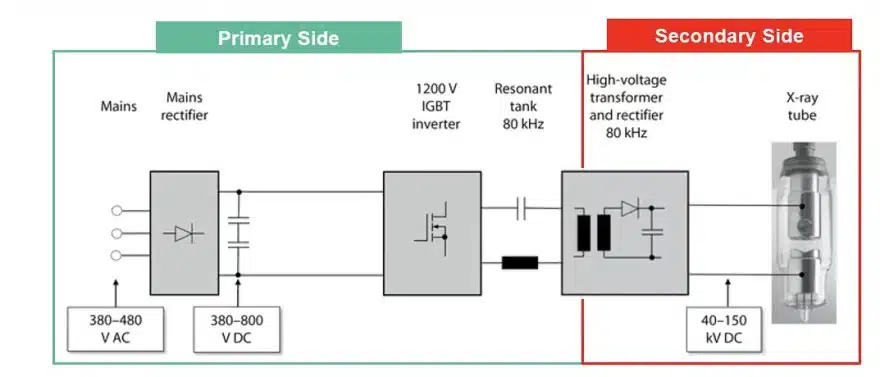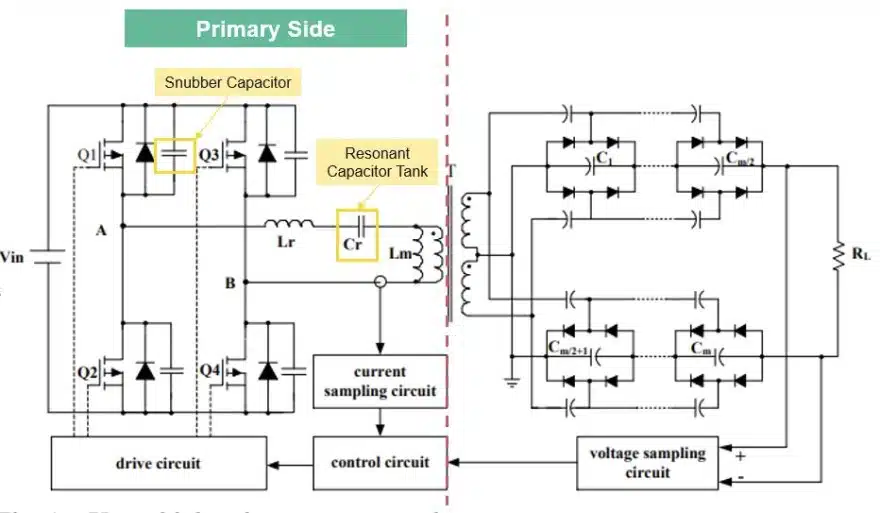This article from Knowles Precision Devices provides an introduction on how to select capacitors for X-ray power supplies that can reliably handle high voltages.
Introduction
As the backbone of the X-ray machine, X-ray tubes produce the radiation that generates the electromagnetic waves known as the “X-ray.” This is done by using a high voltage to accelerate the electrons released by a hot cathode to a high velocity.
Those electrons then collide with the anode, which is a metal target usually made of tungsten.
This process requires an input voltage typically ranging from 180 to 480 VAC with a power supply that transforms and steps up the voltage to extremely high voltage outputs ranging from 10kV and 120kV DC. A high-level diagram of the power supply required to power the X-ray tubes is shown in Figure 1.

If an X-ray power supply is not correctly designed, there can be serious consequences ranging from deteriorated image quality to the release of excessive radiation that can be harmful to a patient. Therefore, X-ray power supply design must be carefully thought through.
Designing X-ray Power Supplies that can Reliably Handle High Voltages
X-ray power supplies need to step up a large amount of voltage in a small package. A popular way to achieve this is to design power supplies for X-ray machines using an LLC resonant converter topology, which uses capacitors in a special way to create smooth, reliable power. A unique feature of any resonant converter, whether used for X-ray machines or other applications such as electric vehicle (EV) or defense power supplies, is that it uses a “resonant tank.” A resonant tank typically includes a large number of capacitors in parallel that work together to create the perfect resonant frequency as the power flows through.
More specifically, looking at the diagram in Figure 1, the primary side of the X-ray power supply handles high voltages and deals with AC-to-DC rectification as well as the DC-to-DC increase of voltage. These functions require special capacitor roles to ensure the power is delivered safely. Let’s look more closely at these different capacitor roles, some of which are shown in Figure 2.
DC-Link capacitors and supporting filtering capacitors – Limits fluctuations to provide a more stable DC voltage.
Decoupling and bypass capacitors – Removes unwanted AC noise that will try to make its way through the system.
Snubber capacitors – Depending on the switching components and diodes chosen, there will be a need to snub out the high-frequency noise resulting from the switching that occurs to transform the AC to DC and then to step up the high voltage DC to extremely high voltage DC.
Safety capacitors – Given the AC voltage on the input rectification stage, it is likely safety capacitors are needed to protect against surges, transient voltages, and possibly perform some electromagnetic interference (EMI) filtering.
Other EMI Filtering capacitors – Throughout the board, other EMI filtering capacitors, besides safety capacitors, will be needed.
How to Fulfil the Many Capacitor Roles Required for X-ray Power Supplies
At Knowles Precision Devices, we focus on designing specialty ceramic capacitors rather than commodity components. This means we are ready to help you fulfill the crucial high voltage, and likely high reliability, capacitor roles discussed above as these components often need specially designed ceramic options. We specialize in providing a variety of options for the high-voltage capacitor jobs that must be done on the primary side of the X-ray power supply and can work with you to discuss options that can meet the extremely high voltage requirements for the jobs on the secondary side of the power supply as well.
While X-ray power supplies may be a newer application space for our capacitors, these devices utilize similar power stages and topologies to the high-voltage power supplies required for EVs and defense and industrial applications – areas where our capacitors are heavily used today. We are also very experienced in supplying components for a variety of high-reliability implantable medical devices. Together, this experience makes our highly skilled team of engineers and ceramic scientists well prepared to guide you through the capacitor selection process for X-ray power supplies. Plus, we can meet strict and tight tolerances and we can perform medical or military grade testing as required.
































